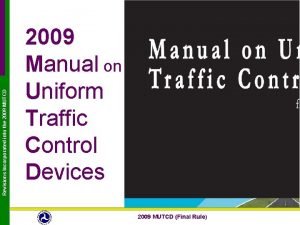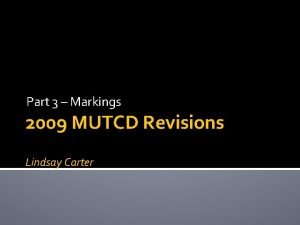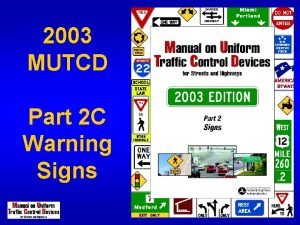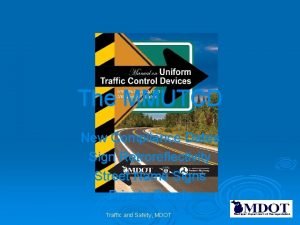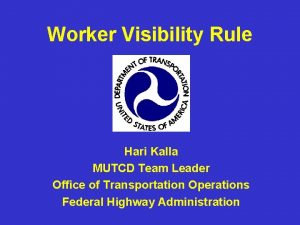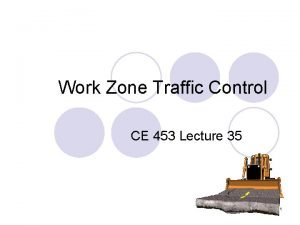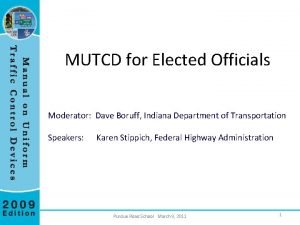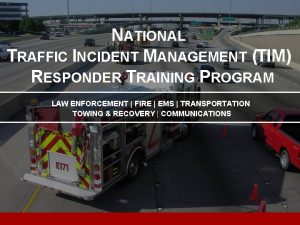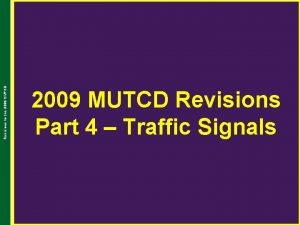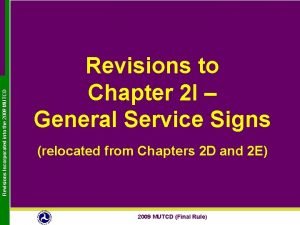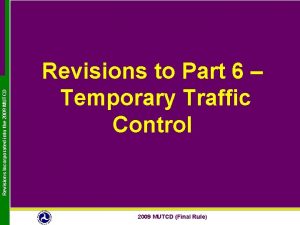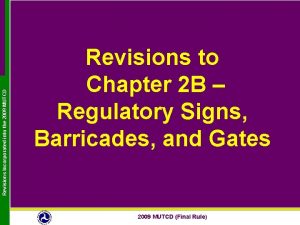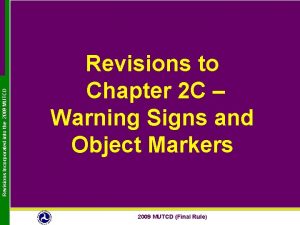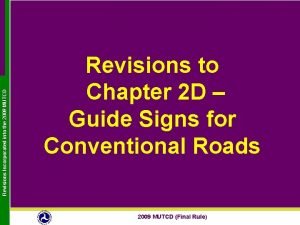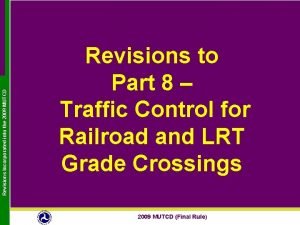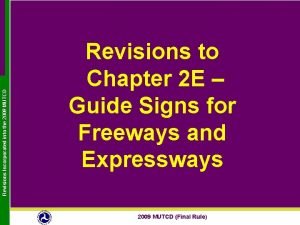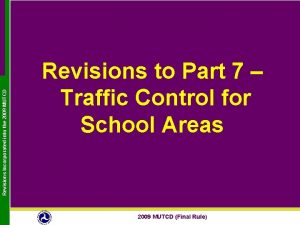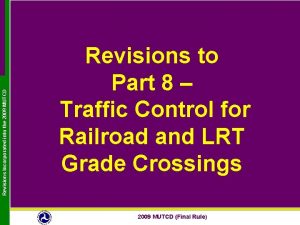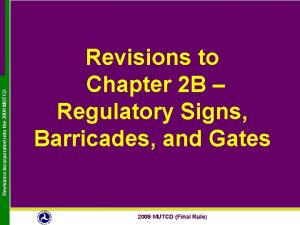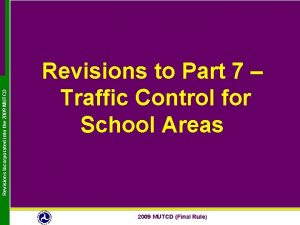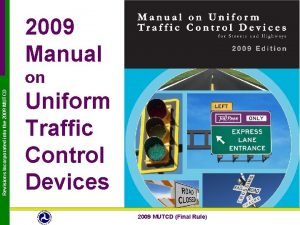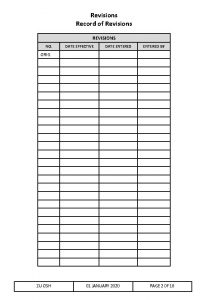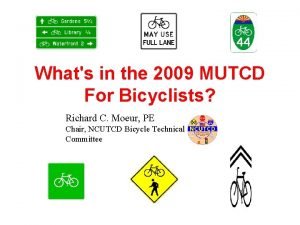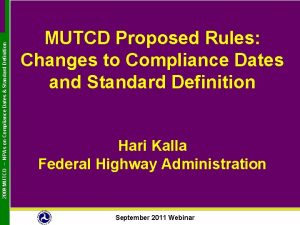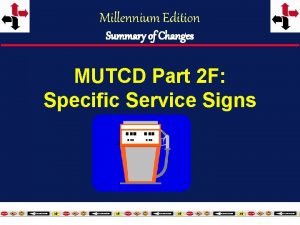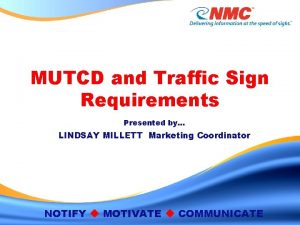Revisions to the 2009 MUTCD Revisions Part 4


































- Slides: 34

Revisions to the 2009 MUTCD Revisions Part 4 – Traffic Signals

Revisions to the 2009 MUTCD Section 4 C. 01 Studies and Factors for Justifying Traffic Control Signals For signal warrants requiring conditions to be met for a certain number of hours, four sequential 15 -minute periods may be considered to be 1 hour if: 1. 2. The separate 1 -hour periods do not overlap each other. The major-street and the minor-street volume are for the same specific one-hour period.

Revisions to the 2009 MUTCD Section 4 C. 05 Warrant 4, Pedestrian Volume In the 2003 MUTCD, this warrant stated that a signal shall be considered if conditions A AND B were both met. The conditions have now been changed and the warrant states that a signal shall be considered if condition A OR B is met. They have added 4 graphs, including reduced volume graphs. Condition A Condition B

Section 4 C. 10 Warrant 9, Intersection Near a Grade Crossing Revisions to the 2009 MUTCD New warrant.

Reorganization of Sections in Chapter 4 D Revisions to the 2009 MUTCD Similar subjects are now grouped together in adjacent sections or combined into a single section.

Revisions to the 2009 MUTCD Chapter 4 D Optional use of Flashing Left Turn Yellow Arrow (FLTYA) for permissive turns.

Revisions to the 2009 MUTCD Section 4 D. 07 Size of Vehicular Signal Indications 12” signal indications shall be used for all signal sections in new signal faces except 6 specific cases where 8” indications can be used. Existing 8” circular signal indications that don’t meet the 6 exceptions may be retained for the remainder of their useful service life.

Revisions to the 2009 MUTCD Section 4 D. 08 Optional Red Indication Clusters

Section 4 D. 11 Number of Signal Faces on an Approach Revisions to the 2009 MUTCD Standard: If a signalized through movement exists on an approach, a minimum of two primary signal faces shall be provided for the through movement (not the major movement). If a through movement doesn’t exist, two primary faces shall be provided on the major turning movement. This same provision should be considered for speeds less than 45 mph

Revisions to the 2009 MUTCD Section 4 D. 11 Number of Signal Faces on an Approach Support: Studies show that locating primary signal faces overhead on the far side of the intersection provides safer operation as compared to postmounting signal faces or locating signal faces overhead within the intersection on diagonal spans. This will be addressed in the Traffic Operations Guidance Manual.

Revisions to the 2009 MUTCD Section 4 D. 11 Recommended number, location, and design of signal faces for approaches with speeds ≥ 45 mph:

Revisions to the 2009 MUTCD Section 4 D. 12 Visibility, Aiming, and Shielding of Signal Faces Guidance: If the posted, statutory, or 85 th percentile speed on an approach is 45 mph or greater, signal backplates should be used. They should also be considered when below 45 mph where sun glare, bright sky, and/or complex or confusing backgrounds exist. A 1” to 3” yellow retroreflective strip may be placed along the perimeter of the backplate.

Revisions to the 2009 MUTCD Sections 4 D. 17 to 4 D. 24 Signal Indications for Left-Turn and Right. Turn Movements These sections specify signal head placement and show detailed diagrams based on the following: 1. Left-turn vs. Right-turn movements 2. Shared vs. Separate signal faces 3. Permissive vs. Protected/Permissive

Revisions to the 2009 MUTCD Typical Arrangement of Signal Lenses in Signal Faces in 2003 MUTCD:

Revisions to the 2009 MUTCD New Arrangements in 2009 MUTCD:

Revisions to the 2009 MUTCD New Arrangements in 2009 MUTCD:

Revisions to the 2009 MUTCD New Arrangements in 2009 MUTCD:

Revisions to the 2009 MUTCD Section 4 D. 18 Signal Indications for Permissive Only Mode Left-Turn Movements (Separate) Standard: If a separate left-turn signal face is being operated in a permissive only left-turn mode, a CIRCULAR GREEN signal indication shall NOT be used in that face.

Revisions to the 2009 MUTCD Section 4 D. 19 Signal Indications for Protected Only Mode Left-Turn Movements Standard: The 2009 MUTCD requires the use of a left-turn RED ARROW and NOT a circular RED indication.

Revisions to the 2009 MUTCD Section 4 D. 22 Signal Indications for Protected Only Mode Right-Turn Movements (Separate) Standard: If a separate right-turn signal face is being operated in a permissive only right-turn mode, a CIRCULAR GREEN signal indication shall NOT be used in that face.

Revisions to the 2009 MUTCD Sections 4 D. 25 Signal Indications for Approaches with Shared Left-Turn/Right-Turn Lanes and No Through Movement (Stem of T-Intersection) This section provides signal face arrangements based on: A. No conflicting vehicular or pedestrian phases. B. Pedestrian or vehicular conflict with one turn movement. C. Pedestrian or vehicular conflicts with both turn movements.

Revisions to the 2009 MUTCD Section 4 D. 25

Revisions to the 2009 MUTCD Sections 4 D. 26 Yellow change intervals and red clearance intervals - Durations shall be determined using engineering practices - Compliance date of June, 2017 - Use of red clearance – changed from option to guidance

Revisions to the 2009 MUTCD Section 4 D. 27 Preemption and Priority Control of Traffic Control Signals Traffic signals with rail-road preemption should have a back-up power supply.

Section 4 E. 06 Pedestrian Intervals and Signal Phases Revisions to the 2009 MUTCD Pedestrian Change Interval (FDW) shall end at least 3 seconds (“buffer”) before the release of conflicting traffic. Buffer shall not begin later than the start of the red clearance interval. Compliance date of June, 2017 or when timing adjustments are made (whichever comes first)

Revisions to the 2009 MUTCD Section 4 E. 06 Slower walking speed for calculating pedestrian clearance time (guidance) Guidance: The Pedestrian Clearance Time should be based on a person walking 3. 5 feet/sec from the curb to the far side of the traveled way being crossed. Guidance: The total of the Walk Interval and the Pedestrian Clearance Time should be based on a person walking 3. 0 feet/sec from the pedestrian detector to the far side of the traveled way being crossed.

Revisions to the 2009 MUTCD Section 4 E. 07 Countdown Pedestrian Signals All pedestrian heads used at crosswalks where the pedestrian change interval is more than 7 seconds shall include a pedestrian change interval countdown display.

Revisions to the 2009 MUTCD Section 4 E. 08 Pedestrian Detectors (guidance) This section provides specific guidance on the locations of pedestrian detectors. Pushbuttons “SHOULD” be separated by a distance of at least 10 feet, unless there are physical constraints that make it impractical.

Revisions to the 2009 MUTCD Section 4 E. 10 Accessible Pedestrian Signals For locations where pushbuttons are placed less than 10 feet apart, each accessible pushbutton SHALL be provided with the following features: A. B. C. D. A pushbutton locator tone A tactile arrow A speech walk message for the WALKING PERSON A speech pushbutton information message

Revisions to the 2009 MUTCD Section 4 E. 11 Accessible Pedestrian Signals For locations where pushbuttons are placed more than 10 feet apart (guidance from section 4 E. 08), the audible walk indication SHALL be a percussive tone. The percussive tone shall repeat at eight to ten ticks per second.

Section 4 E. 11 Accessible Pedestrian Signals Revisions to the 2009 MUTCD When speech messages are used, they should be patterned after the following: A. “Broadway. Walk sign is on for Broadway. ” (when pedestrian phase is concurrent with a vehicle phase) B. “Walk sign is on for all crossings. ” (for exclusive pedestrian phasing) C. Shall not contain additional information (“Street” or “Avenue”) unless it is necessary to avoid ambiguity at a particular location.

Revisions to the 2009 MUTCD Section 4 E. 11 Accessible Pedestrian Signals If a pilot light is used at an accessible pedestrian signal location, each actuation shall be accompanied by the speech message “wait. ” If a speech pushbutton information message is used, it shall begin with the term “Wait, ” followed by intersection identification information and modeled after “Wait to cross Broadway at Grand. ”

Revisions to the 2009 MUTCD Chapter 4 F Pedestrian Hybrid Beacons

Revisions to the 2009 MUTCD Section 4 L. 02 Intersection Control Beacon If two horizontally aligned red signal indications are used on an approach for an Intersection Control Beacon, they shall be flashed simultaneously.
 Mutcd 2009 edition
Mutcd 2009 edition Mutcd part 3
Mutcd part 3 End of a divided highway sign
End of a divided highway sign Mutcd
Mutcd Mutcd chapter 2
Mutcd chapter 2 Mutcd
Mutcd 23 cfr 634
23 cfr 634 Termination area mutcd
Termination area mutcd Indiana mutcd
Indiana mutcd The mutcd states all workers including emergency responders
The mutcd states all workers including emergency responders Mutcd chapter 4
Mutcd chapter 4 Từ ngữ thể hiện lòng nhân hậu
Từ ngữ thể hiện lòng nhân hậu Diễn thế sinh thái là
Diễn thế sinh thái là Giọng cùng tên là
Giọng cùng tên là Slidetodoc
Slidetodoc 101012 bằng
101012 bằng Bài hát chúa yêu trần thế alleluia
Bài hát chúa yêu trần thế alleluia Hươu thường đẻ mỗi lứa mấy con
Hươu thường đẻ mỗi lứa mấy con đại từ thay thế
đại từ thay thế Vẽ hình chiếu vuông góc của vật thể sau
Vẽ hình chiếu vuông góc của vật thể sau Quá trình desamine hóa có thể tạo ra
Quá trình desamine hóa có thể tạo ra Cong thức tính động năng
Cong thức tính động năng Thế nào là mạng điện lắp đặt kiểu nổi
Thế nào là mạng điện lắp đặt kiểu nổi Các loại đột biến cấu trúc nhiễm sắc thể
Các loại đột biến cấu trúc nhiễm sắc thể Lời thề hippocrates
Lời thề hippocrates Vẽ hình chiếu đứng bằng cạnh của vật thể
Vẽ hình chiếu đứng bằng cạnh của vật thể Bổ thể
Bổ thể độ dài liên kết
độ dài liên kết Môn thể thao bắt đầu bằng từ chạy
Môn thể thao bắt đầu bằng từ chạy Khi nào hổ mẹ dạy hổ con săn mồi
Khi nào hổ mẹ dạy hổ con săn mồi điện thế nghỉ
điện thế nghỉ Thế nào là sự mỏi cơ
Thế nào là sự mỏi cơ Một số thể thơ truyền thống
Một số thể thơ truyền thống Trời xanh đây là của chúng ta thể thơ
Trời xanh đây là của chúng ta thể thơ Chó sói
Chó sói
